VxRail - hyperconvergent system for all times

Last summer, we wrote about the advent of hyperconvergence in the storage industry. And in accordance with the trends of time and customer needs, we present a new product - a fully integrated, configured and tested VxRail hyper -convergent system , created on the basis of vSphere and Virtual SAN.
Surely you are all familiar with the marketing theory of the " four R ". How can VxRail be described within this theory?
- Pricing (price) . It starts with $ 60 thousand. This is especially important for the market where the “start small” approach and will scale will be popular.
- Product . Modern hyper-convergent solutions require the use of only Flash-drives. They need deduplication, compression, coding with erasing erroneous characters (erasure coding). They require flexible configuration, advanced inline and remote replication. They need to integrate cloud object storage and NAS support. Finally, such solutions should simplify the operations of the “second day” to a single mouse click.
- Positioning (positioning) . If someone believes that one convergent or hyperconvergent solution can satisfy any need, then this person is greatly mistaken. In reality, some customers may well be satisfied with a single product and scale it, but most need different solutions:
- Vblock can be used in large data centers with the traditional nature of the load.
- VxRack is suitable for installation in large data centers if the customer wants to scale the system VERY much, and the phrase “don't think about the network” is equivalent to the planned failure.
- VxRail is designed to create initially small systems that can later be scaled.
- VxRail is also well suited for SMB and SME. 64 nodes in 16 blocks can pull over 3,000 virtual machines and serve numerous companies.
- Finally, VxRail allows you to implement work standards specific to data centers at the company level, provides integrated management and simple workload relocation.
- Packaging The role of this feature of the product can be very important in the development of the company.
- VxRail was designed by a single product team from VMware and EMC. And all further releases will also be created by this team.
- VxRail is the only hyperconvergent device with a single model of support for all software from VMware. Of course, VSAN nodes can also have uniform support for VSAN and hardware, but a hyperconvergent device is more than just an equipment with an SDS stack.
- VxRail integrates with VxRack and Vblock, which allows you to create a system for any level and profile of the load. VxRail also uses the full potential of VCE Vision, provides replication and protection both in the company scale and in the data center, under any loads.
Despite the flattering assessment of the position taken by the EMC according to Gartner and IDC , the assessment of our customers is more important. According to their reviews, the cumulative savings from the introduction of converged infrastructure (in the terminology of Gartner - Integrated Infrastructure Systems) exceeded $ 3 billion year on year.
')
We received a lot of positive feedback from our customers who use Vblock in high-loaded data centers, including those with the most common types of loads. If your workloads do not require the simultaneous scaling of processor and storage resources, then a converged infrastructure may be the best solution. And in this field, the strongest player is Vblock, which we continue to develop and improve. In this direction, EMC and Cisco double the stakes.
Of course, we are not perfect. Nevertheless, we are not afraid of competition, we listen carefully to our customers, and we are constantly working on our development. It is very dangerous to consider your position unshakable.
Curiously, but apparently, Vblock is becoming a household name for a converged infrastructure. Funny, but sometimes Cisco UCS is screwed to all sorts of “Vblock”. And we also want to tell about our developments in the field of hyperconverged systems architectures.
We have customers using VxRack on data center-level systems in which a hyperconvergent, horizontal-scalable model works perfectly. And to be honest, I would have run away (and not gone) from someone who is immediately deploying hundreds of nodes, without introducing ToR switches and network Spine / Leaf architecture. After all, it allows you to scale up to hundreds and thousands of nodes deployed not in small clusters, but in the form of a large horizontally-scalable rack-mount (Rack-scale), cloud-based (Web-scale) or hyper-scalable (Hyper-scale) system.
Some customers invest in VxRack, creating systems from hundreds of nodes, and continue to build them. For comparison: some of these customers spend approximately 1/20 of annual income on these hyper-convergent "unicorns" at a time ... And the share of VxRack is growing rapidly.
However, our product line lacked an entry-level solution to start small and easily scalable into a large system. Such a solution would be required for the creation of corporate systems and the organization of remote / regional offices. It would also interest those in whose data centers hundreds or thousands of virtual machines could work. But this "start small" we did not have. And previous attempts to create such a decision were unsuccessful.
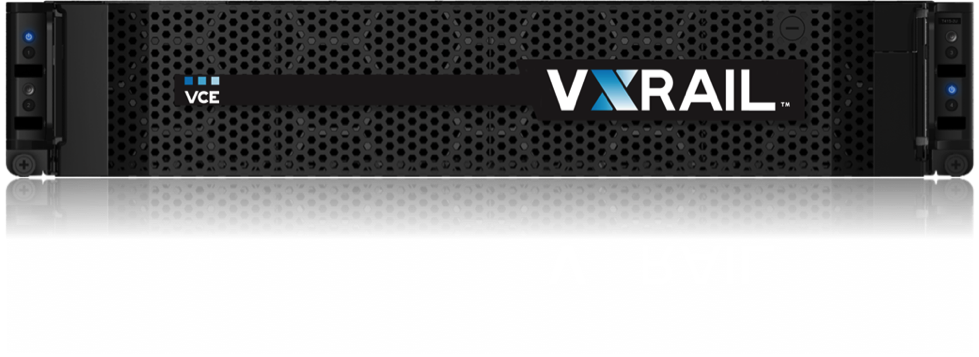
Now we have VxRail, which should close this niche. And we believe that we managed to make a good product.
History of creation
In 2015, VMware and EMC development teams aggregated our knowledge of this market segment.
- We found out that our customers like vSphere and VMware, and for many of them this bundle has become a kind of industry standard. The segment of corporate data centers is extremely heterogeneous. For example, in this market, Vblock and VxRack act as heterogeneous platforms. But in many other markets (divided by segmentation and usage scenarios), VMware products have been the standard.
- We found that separate software and hardware development no longer works. As a result, poorly adapted and insufficiently integrated configurations are obtained, and the capacity for innovation remains insufficient (software and hardware slow down due to the complex architecture created by several different development teams).
- We found out that our customers needed much more flexibility than we thought. On the one hand, they want simplicity, but much more. They need flexibility in configuration, maintenance and support. They want to use their ELA.
- We found out that there is a critical set of properties and capabilities, without which you are not competitive.
As a result, we have united the developers of both companies into one team. Now the VxRail development team is literally a single fully integrated organization whose members have worked together for more than 200,000 people / hours. And this is just the beginning.
Their task is simple: to create and deliver the best device on the market hyper-converged infrastructure. First of all, it is focused on those customers who use the vSphere hypervisor as a standard. The device should be as simple as possible to deploy, scale and maintain. VxRail satisfies all of these criteria. It integrates with VxRack and Vblock, allowing you to create convergence / hyperconvergent systems that are unmatched.
VxRail is an unusual product for both our companies and the only device of hyperconvergent infrastructure. It is important to understand that VMware supports an open ecosystem of hyperconvergent software elements — vSphere, VSAN, and VSAN nodes. Customers need a choice. It is also possible to introduce your own add-ins into VSAN nodes for the sake of solving specific tasks.
But if you need a turnkey hardware solution, then pay attention to VxRail from VMware and EMC.
Undoubtedly, there are many skeptics. Someone will point us to previous failed attempts. Well, we live, work, study, adapt and move on. I am SURE that competitors of all stripes will pounce on us. Welcome!
But ultimately, the main thing is what our customers and the market say. Nevertheless, I still reinforce their voices with my own point of view:
- Customers need a solution package that covers the whole range of their tasks and includes various types of infrastructure: blocks, racks and devices.
- Customers are interested in long-term partnership.
- Customers are looking for partners who can provide solutions that work on top of the converged / hyper-converged infrastructure stack — IaaS, PaaS, and data fabric.
- Clients are looking for partners who are not only aware of the criticality of technology and innovation, but also understand the need for support, service, and a shared vision. While separate support models for software and hardware may exist for VSAN nodes, uniform support is the best model for a single device. "One window service".
Dirty technical details
Let's look at some technical points.
First of all, you need to understand that we classify VxRail exactly as a device. It looks like this:

So the term "device" means a product that is installed in your rack and is fully ready to work within the existing network infrastructure. At the same time, this implies the possibility of modular scaling using blocks. This is a fairly common solution today, and I think that this includes the entire Gartner Hyper-Converged Infrastructure System (HCIS) segment. “Start small, scale and update easily.”
This is different from what we ourselves would attribute to the “hyper-converged rack system” (Hyper-Converged Rack Scale System). In general, the concept of “rack” looks somewhat vague. If for devices, the motto is “Start small, scale easily and update”, for the rack-mount class the motto is “Start with BIG, easily scale and update”. A key component of the design and control stack of such a system should be a switching module, since it is a priori larger than the device. In addition, a rack-mount system usually includes a much wider set of equipment, often in the form of “composite” or “composable” architectures. You cannot simply add a network component, the network must be part of the system, with a single support, life cycle, warranty and unified management. That is, the network is an integral part of the rack system. There is no such thing in any (!) Product of the Hyper-Converged Appliance (HCA) class. VxRack belongs to this class, but we'll talk about it another time.
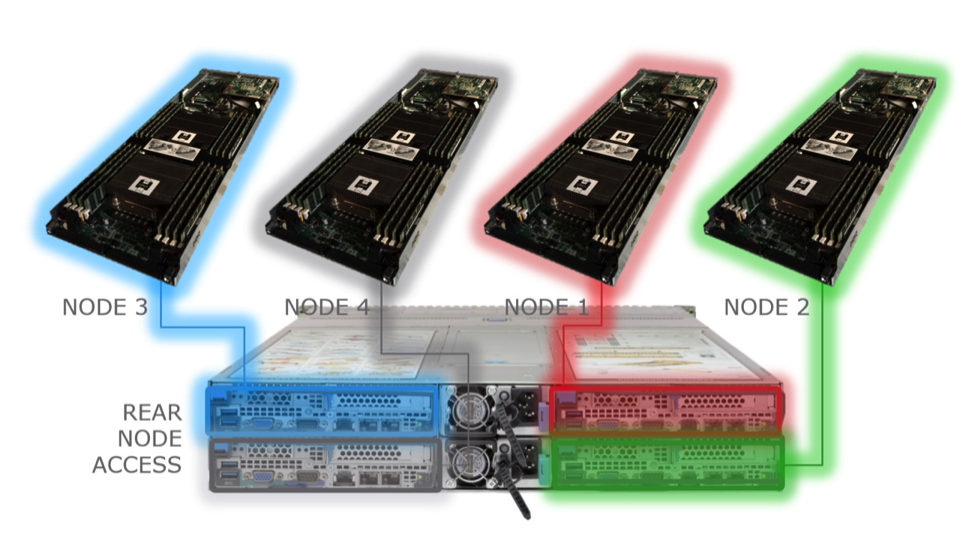
VxRail comes in a very popular 2U4N form factor (4 modules of 2U form factor). The minimum number of nodes - 4, you can scale in steps of 1 node.
Do not underestimate this small device, it has high performance:
- 112 CPU cores
- 2 TB DRAM
- 76 TB of flash memory
- Eight ports of 10 Gbps
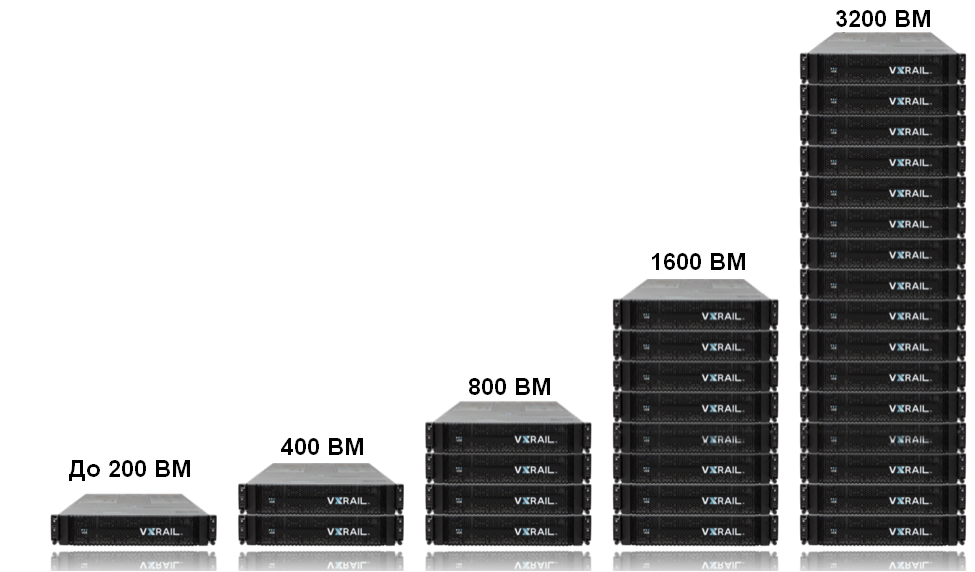
A VxRail cluster of 16 devices (16 x 4 nodes = 64 nodes) can hold more than 3000 virtual machines, performs millions of I / O operations per second, has a total capacity of 1.2 PB (before using deduplication and compression). It's a lot.
By the way, if you already KNOW that you will be scaled to such a size, then it’s better to start thinking about using racks right away, plan your Spine / Leaf network and consider using VxRack. But if you are not sure yet, then you can start small and grow as needed.
When I said that our customers want more flexibility in configuration, I meant this:
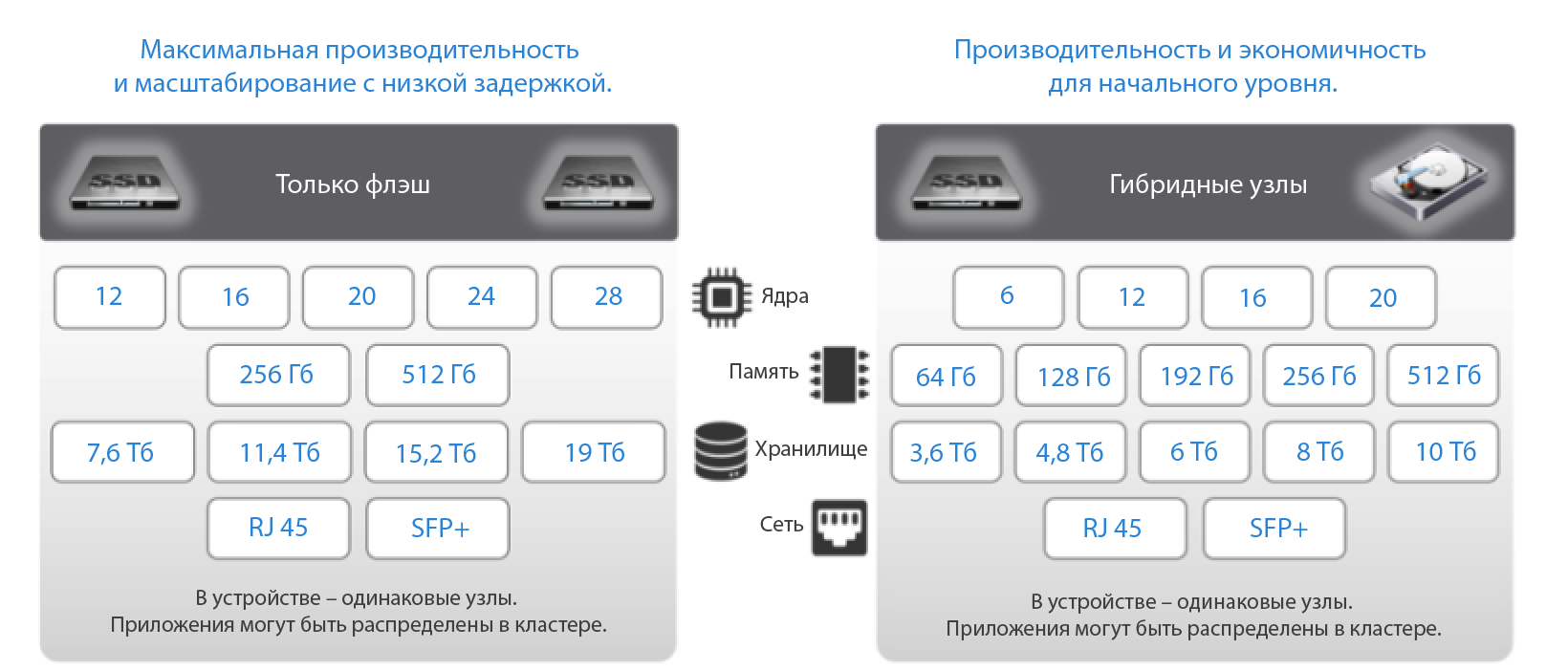
Such configurability is reflected in the following hybrid models:
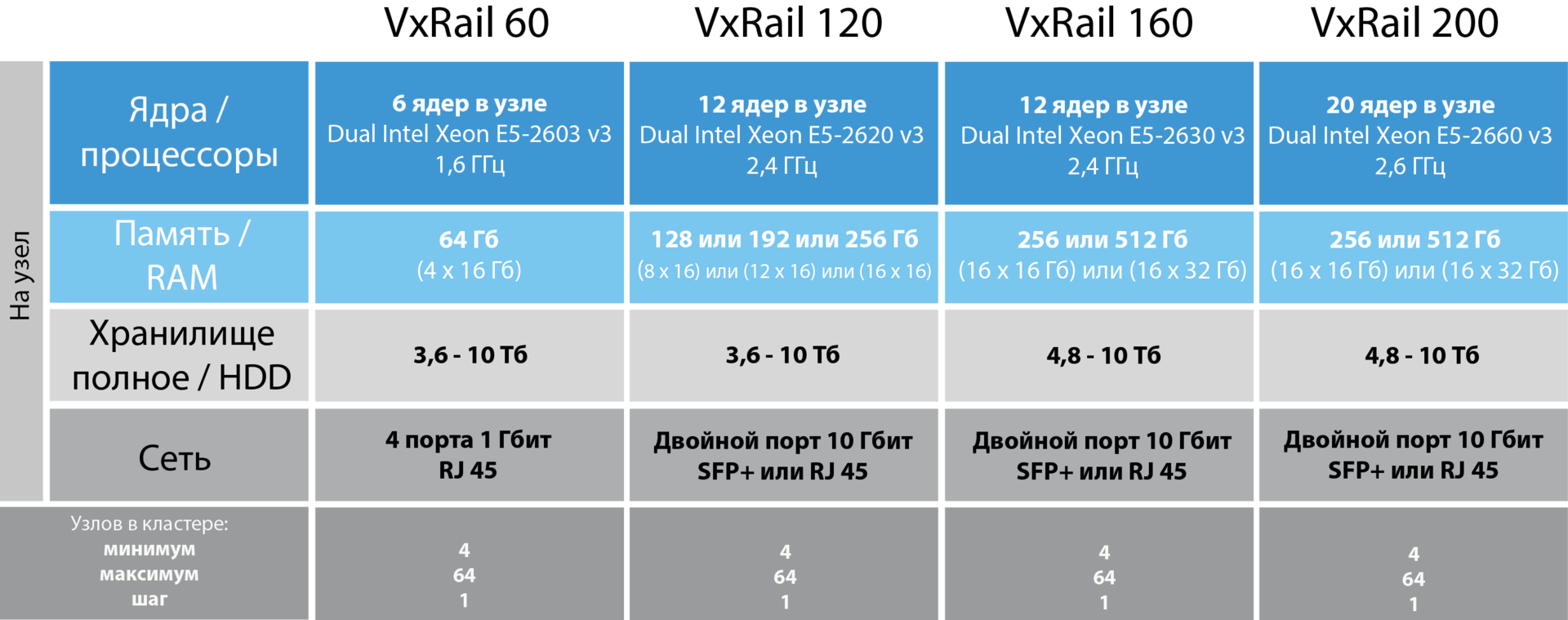
and flash models:

Not all models will be introduced to the market at the same time, some will be available in the second quarter. Also scheduled is a series of software updates (for all configurations, including VSPEX Blue owners) that will add new features and capabilities.
I believe that flash models will be in greater demand than hybrid models. It is likely that a turning point has come, when the flash configuration is preferable for any kind of transaction load (and virtual machines are a transaction load). And the reason is not even that deduplication, compression and other data compression functions have been developed for flash. There are simply no more barriers to staying on hybrid systems. Power consumption, cooling, I / O operations, delay, throughput, predictability, fewer failures - everything speaks in favor of the flash. This is true not only for external SAN solutions (XtremIO, flash version of VMAX), but also for transactional configurations based on SDS.
The lion's share of any hyper-converged infrastructure device is SDS, because in fact it defines the behavior and features of the system.
Using VxRail is a logical step for those who bet on vSphere. In such cases, the VSAN is beyond doubt the strongest SDS. Virtual SAN 6.2 is actually something incredible, you can read about its capabilities here .
Let's return to our sheep. I hope you understand the potential of modern flash systems, data compression capabilities, and other advantages that are characteristic of the SDS integrated target code level. But if we need a non-transactional repository? If we need a NAS to exchange data via CIFS, or NFS?
Historically, hyperconvergent devices are not too good to use in non-transactional scenarios when the emphasis is on storage. We had to break our heads, but we still managed to teach VxRail to fully utilize almost any S3-compatible cloud object storage for cold virtual machines and archives, as well as any NFC, CIFS and iSCSI storage. Each device comes with a 10 TB license. It remains only to connect any object storage.
As for security, all data is encrypted and compressed. If this is not enough for you, then you can use our best and most economical S3-compatible object storage - Elastic Cloud.
What about inline and remote replication? Surely because VxRail in this regard, like most of the HCIA, has a somewhat limited set of data services? Not. Here corporate-level replication technology is implemented, which includes a consistency group, virtual-machine-level replication, low RPO asynchronous replication, and continuous replication. Do not forget also compression and deduplication via WAN, some of the best in the industry. Each device comes with a license for 15 virtual machines, the number of which can be easily increased. RecoverPoint for virtual machines is available, fully integrated into the vSphere Web Client.
VxRail has built-in data protection, but can also replicate to other instances of VxRail. In addition, if you use a specialized data protection platform, Data Domain, you can immediately integrate a turnkey VxRail into it. This will allow you to quickly and easily create backups and recover from them. To unload the network, DDBoost is used, full deduplication and data protection from the periphery to the “edge <-> core” center are supported. No other hyperconvergent device provides such capabilities.
Need simple “stretched” clusters? You are welcome.
Finally
So, VxRail:
- Connects to existing standards. If you are using VMware, and a small / medium business or large company with remote offices and branches, you can no longer look for other solutions.
- Extremely simple.
- It has a low cost ($ 60 thousand).
- Scale well (up to 64 nodes!).
- Allows you to scale and perform the operations of the "second day" by simply pressing a button.
- It has the best performance on the market.
- Available in flash configurations. It's 2016, why not completely switch to flash?
- It has wide data compaction capabilities (deduplication, compression).
- Provides efficient erasure coding, saving money.
- It has unique capabilities in the use of cloud object storage and internal NAS.
- Can connect to your standards from peripherals to the center:
- For integration with VCE Vision for the sake of providing support, monitoring resource consumption and system status.
- For disaster recovery (supports corporate-level replication: consistency groups, synchronous / asynchronous / continuous RPO, protection at the level of virtual machines, easy integration with your standard management tool.
- For backups. Fits into your current infrastructure and does not require additional investments. If you are using a Data Domain, then VxRail starts working immediately.
VxRail allowed us to complete a harmonious product line, thanks to which we can realize a full-fledged distributed enterprise:
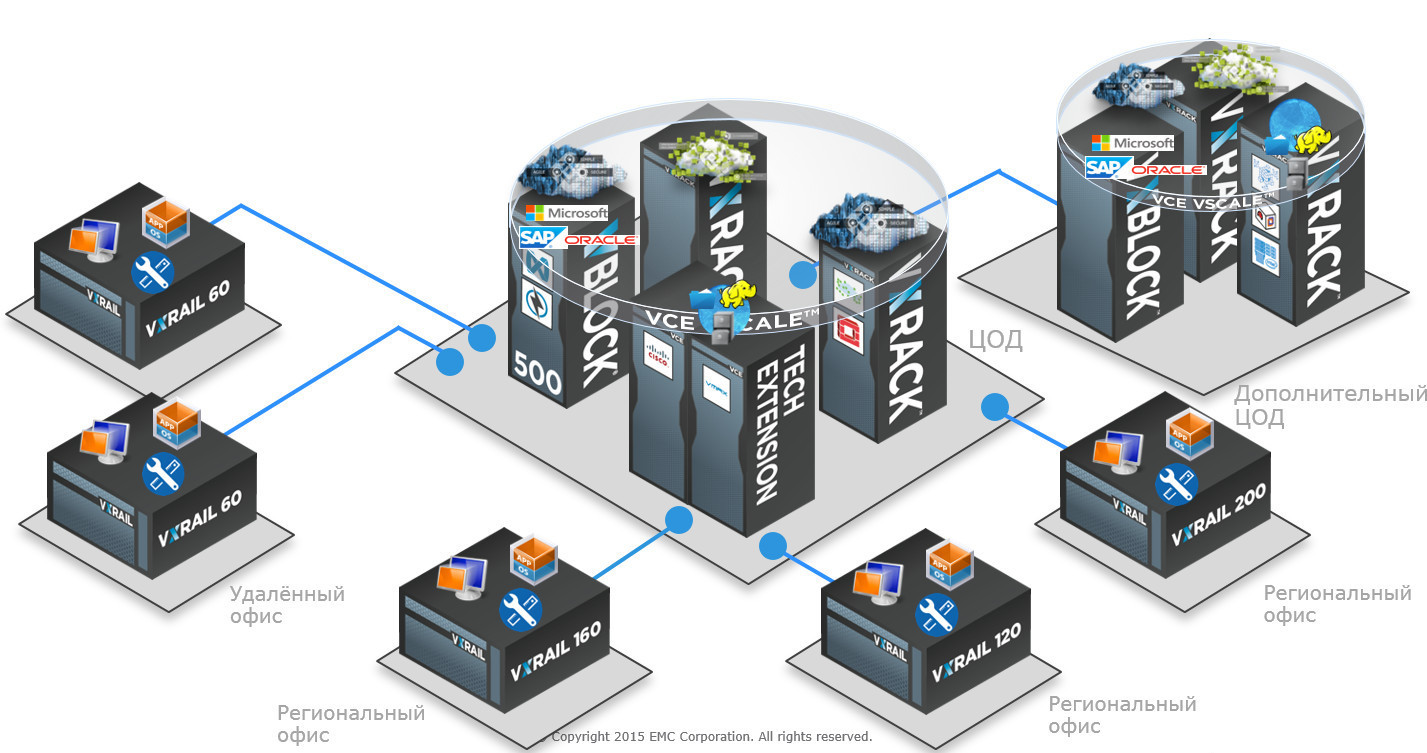
Finally, I would like to quote the words of two people - our client and our partner, who have extensive experience in using not only our products, but also the products of our competitors.
Partner:
Adding VxRail to the VCE family will allow us to offer our customers a comprehensive package of converged systems for almost any use case. vBlock and VxBlock are for Tier 1 class loads, VxRack is for Tier 2 class environments, and VxRail is ideal for organizing remote / regional offices.
Customer:
VxRail gives us the opportunity to scale from our mobile infrastructure up to a full-fledged data center, built entirely from one-vendor solutions.
Our mobile infrastructure for the season covers about 75,000 miles, providing the Formula 1 Renault Sport team with the necessary level of IT support for each race. The compactness of the VxRail is good for us, because our equipment has to operate at high temperatures, in confined spaces and other difficult conditions. We also like the fact that this solution supports our workloads and the amount of data generated without limiting us.
I can already estimate the time and cost savings that we get from deploying a dense, independent, hyper-convergent 2U rack. From the point of mass, we will save about $ 200,000 in air travel for the season. And ease of installation will allow us to deploy the system much faster before the race.
Hyper-converged infrastructure provides constant availability, fast response and time saving, all thanks to an independent 2U device that works without question.
Antony Smith, Formula 1 team Renault Sport, managing IS-infrastructure.
Source: https://habr.com/ru/post/277855/
All Articles